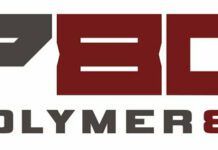One of the hottest trends in firearms sales is the resurgence of pistols chambered for 380 Auto or 9mm Browning. This cartridge is also referred to as 9mm Kurz or 9mm “short.” However, scarcity of available ammunition remains a problem. We checked with several retailers and found they were hesitant to sell quantities of 380 ammunition unless the customer was actually buying a 380-caliber handgun. It wasnt until our local gun shop made contact with a wholesaler by the name of Camfour (www.camfour.com) that we were able to locate the necessary quantity of ammunition to complete our tests. But with so many new 380s in the offing, supply of ammunition is bound to catch up.
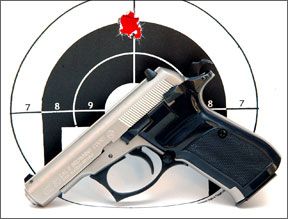
We begin our tests of available 380s with two models that have been in production for so long they are, in regards to marketing, almost invisible. They are the $522 CZ USA Model 83 and the $900 Sig Sauer P232. Our third gun was the $393 Walther PK380. The PK380 has been available for little more than one year. The fourth gun represents the new generation of 380 ACP pistols. The $643 Sig Sauer P238 is a much smaller pistol with little pretense towards filling the role of a primary carry gun.
Our test procedure was broken down into two phases of operation. Phase one was to determine base accuracy. We wanted to know what kind of groups could be shot with each gun from sandbag support. Test distance was 15 yards. Our point of aim was the white 1.9-inch circle at the heart of the Reckstine Sight-In Target. This test was performed outdoors.
To assess the close-quarter capabilities of each pistol, we utilized a three-shot drill fired at close range upon a Hoffners ABC16 target. Placed 5 yards downrange, we recorded elapsed time beginning with the audible start signal from our Competitive Edge Dynamics electronic shot recording timer (www.cedhk.com). The drill was to fire two shots into the 5.5-inch-wide by 7.9-inch-high A-zone at the center of the humanoid print and then a third shot to the B-zone or cranial pocket. The B-zone was represented by a semi-circle about 5 inches wide and 3 inches high. Start position was with the gun held in both hands pulled in towards the chest with the muzzle raised at approximately a 45-degree angle. We recorded elapsed times for 10 three-shot strings of fire. This test was performed indoors at the newly renovated Top Gun Handgun Training Center in Houston (www.topgunrange.com). Here we benefitted from a state-of-the-art air filtration system and the safety of ballistic partitions, plus a splash-proof backstop. Lighting was adjustable from back-alley dim to classroom bright. We also noticed digital multi-screens behind the counter and behind the scenes in the administrative offices. Not only was unsafe handling quickly addressed by staff, but our vehicles were under constant surveillance as well.
Test ammunition consisted of full metal jacket fodder and an innovative defense round from Hornady Manufacturing. Our FMJs were the 92-grain rounds from the Czech Republic by Sellier & Bellot, and 90-grain rounds of PMC Bronze from Korea. To determine carry weight of each gun at full capacity, we weighed each gun (unloaded) with a full magazine plus one round of the 92-grain Sellier and Bellot ammunition. During our break-in session, we fired a variety of rounds, including Hornady XTP hollowpoints. But for recording accuracy data, our third test round was the new 90-grain Hornady Critical Defense ammunition. These rounds, manufactured in Nebraska and sold in boxes of 25, were constructed with a filled hollow point to ensure expansion at any velocity in any media. What struck us was that all four guns ran without a single malfunction. Another aspect was that every round we tried in all four guns, regardless of being offered as target ammunition or for defensive purposes, resulted in about the same amount of felt recoil. Usually, target rounds are softer and defensive rounds leave our hands sore. The test turned out to be a lot of fun. Here is what we learned.
CZ USA CZ 83 No. 91302 380 ACP, $522
The CZ 83, now available from CZ USA, located in Kansas City, Kansas (www.cz-usa.com), has been in the catalog in one form or another since 1982. Thats when the Czechoslovakian military received its 380-caliber pistols. The Model 83 appeared
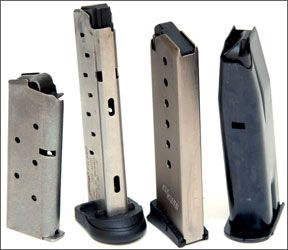
the following year for civilian sales. The CZ 83 is also available chambered for 32 ACP. The 380-caliber models come finished in blue steel or satin stainless. The satin-nickel slide on our CZ 83 was stamped Cal. 9 Browning Court. This is yet another name for 380 Auto. (Wikipedia lists as many as 10 different names for this cartridge.) The steel frame was also finished with a satin-nickel sheen, but other parts were glossy blue. These parts were the trigger guard and ambidextrous magazine release, the ambidextrous safety levers, the hammer, and the sights, front and rear. The grips were black plastic panels that left the backstrap exposed.
Our Model 83 arrived with two steel-bodied magazines that held 12 rounds of ammunition staggered side by side above a removable steel basepad that seated flush to the bottom of the frame. Other notable characteristics were the externally mounted extractor, rear only cocking serrations on the slide and a white dot front sight blade. The rear sight, also showing white dots, was dovetailed into the slide and fixed with a small vertical pin.
The CZ 83 was blowback operated, wherein the 3.8-inch-long barrel was fixed to the frame. Field stripping the pistol begins with an empty pistol, hammer down and safety off. Then, pull the trigger guard forward and down until it hinged away from the frame. Next, the hammer was pulled back to make it easier to move the slide. The slide was pulled to the rear until it was released from the frame rails. The slide was then slid forward over the muzzle and removed. So was the stout recoil spring that surrounded the fixed barrel. Reassembly meant applying the slide over the barrel, letting it forward and snapping the trigger guard upward into position. Unlike many other blowback pistols, the CZ 83 had a left-side lever that can be used to lock back the slide.
The trigger system offered both traditional double action (TDA) and single-action only (SAO) fire. Once the slide was moved to load the chamber, the safety could be applied with the hammer back for cocked and locked carry. Or, the hammer could be lowered for a first shot double action with single-action only shots to follow. Without a decocking lever in place the hammer needed to be lowered manually. This meant grasping the hammer and holding it back. Then, pressing the trigger until a click was heard. At this point the trigger was released but the hammer remained in our grasp. We gently lowered the hammer. Actually, once the click sounds and the trigger has been released there should be no danger of ignition. Thankfully, the hammer was properly shaped and large enough so that we didnt feel our grip on the spur was ever in question. Plus, there was room for us to grasp the hammer with one finger wrapping partially around the hammer blocking the firing pin. Were not sure the CZ 83 was actually meant to be carried with the hammer back at all times. Rather, the safety may best be applied at the conclusion of live fire for safe holstering. This would maintain a higher state of readiness should a safe situation take a turn for the worse.
In performing our action tests we decided to engage the target utilizing both the single-action only and traditional double-action options. For TDA fire we manually decocked the gun before every run. Fired in this manner elapsed times varied from 1.99 seconds to 2.23 seconds. The computed average elapsed time of 2.13 seconds was actually a few tenths of a second longer than we needed to guarantee all hits landing where they were supposed to. Stray hits were no more than about one-inch outside either the A or the B zones.
Firing our action test, single-action only proved to be considerably faster. Elapsed times ranged from 1.73 seconds to 2.10 seconds. Many strings of fire completed in about 1.9 seconds produced perfect shot placement. Shots from the bench were also fired single-action only. The Hornady Critical Defense ammunition printed five-shot groups measuring about 1.5 inches across on average. The PMC Bronze ammunition was less satisfying, averaging about 1.9 inches across for five shots
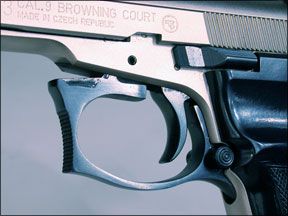
measured center to center. But the Sellier & Bellot ammunition was stunning. We printed a one-hole group that, after deducting for one-half the bullet diameter at the top and one-half the bullet diameter at the bottom, measured about 0.5 inches across. Loaded into the CZ 83 the Sellier and Bellot 90-grain jacketed ammunition was the only round to exceed 1000 fps in our tests. As such, muzzle energy was also the greatest, measuring 208 ft.-lbs. on average.
The CZ 83 held 12+1 rounds, making it the only high-capacity pistol in the test. It transmitted the least recoil while producing the most power. The magazine release was partially blocked by the contour of the grips, but shooter comfort and bold sight index made this gun easier to shoot. We never felt in danger during the manual decocking process and both the double- and single-action triggers were among the best weve tried. The ambidextrous thumb safeties did not require that we change our shooting grip. Detent on each lever was of the correct strength in our opinion. There were no points of snag to spoil concealed carry, and its size and weight were most acceptable.
Our Team Said: Compact and efficient, the CZ 83 may be the best example of a traditional double-action pistol weve tested. Accommodations for safe, manual decocking were well prepared. 12+1 capacity and exceptional ergonomics provided the correct size grip and proper index to the thumb safeties as well as to the trigger. This is a great semiauto for those who desire low recoil.
Sig Sauer P232 No. 232-380-SSS 380 ACP, $900
If you search the sigsauer.com website, the 232-series pistols are just about the last entry on the drop-down menu. Under the description tab, the P232 is referred to as the smallest pistol in the Sig Sauer catalog. In lieu of an update we would assume the P232 is now the second smallest pistol (after the P238). Three versions of the 232 were listed, each one topped with night sights. But there was a significant difference in cost and in weight, too. The blue model with polymer grip panels was listed at $720 and weighs 17.6 ounces. The two-tone added a stainless slide and “smooth contours and snag free edges.” Weight was listed as 18.5 ounces with a suggested retail price of $826. Our all-stainless model with rubber Hogue grip was listed as weighing in at 23 ounces but registered 22.1 ounces (empty) on our My Weigh KD600 scale. List price was $900.
The Sig Sauer P232 was designed to be concealable, and several mechanical features, aside from the smoothing upgrade, contributed to its slick profile. The takedown lever was countersunk into the frame. The decocker was held as close to the frame as possible-so close that working this lever required us to use our left thumb. The hammer spur was short and almost completely shrouded by the rear of the slide. Magazine retention and release was achieved by a catch at the bottom of the magazine well. By not utilizing a button release that crossed the front strap, the P232 was inherently slim. The security of a bottom catch can pay off should a position of concealed carry inadvertently apply lateral pressure to the pistol. Certainly, a reload will take more time, but this pistol is being marketed as a backup, holding perhaps the final eight shots of a confrontation in its single-column magazine.
Like the CZ 83, the Sig Sauer P232 operated by straight blowback with a fixed barrel with a TDA, or double-action/single-action trigger. Whereas the CZ 83 was equipped with a slide lock/release lever, the P232 required an empty magazine in place to lock back the slide. There was, however, a manual decocking lever mounted on the right side of the frame just behind the upper rear corner of the trigger guard. The takedown lever was located high on the frame immediately forward of the trigger guard. To remove the top end, we emptied the gun and rotated the takedown lever to a vertical position. Next we pulled back the hammer and retracted the slide until it could be lifted from the frame. The only other part to be removed was the recoil spring, which surrounded the fixed barrel.
Two magazines were supplied with our P232, and as mentioned before, there were no malfunctions. We liked the Hogue grips, but for deep carry theyre bulky and the rubbery surface was tacky. The finger grooves did make the gun easier to grab from a holster, however. The grip covered much of the back but contributed little to buffering recoil. The P232 reminded us of the Walther PPK pistols in that the gun felt rigid and it recoiled hard into the web of our hands, an area not covered by the grip. Of our four pistols we would say that the P232 was the only gun to present an uncomfortable level of shock from the 380-caliber ammunition.
From the 15-yard bench we were able to produce groups measuring less than 1.5 inches across with each choice of test ammunition. The best overall match for the P232 was the Hornady Critical Defense ammunition. We regret printing a 1.4 inch group as we were able to shoot 1.1 inch groups with regularity. This may be nit-picking, but when we endeavor to collect accuracy data we live in a world divided by tenths of inches. Actually, we felt hampered by the smallish trigger guard. No matter how we engaged the trigger our index finger seemed to contact the lower surface inside the trigger guard. But the sight picture was very clear. The front sight was effectively low mounted to keep the gun slick. The rear sights were necessarily taller but their overall width was narrow.
At Top Gun we engaged targets beginning with first-shot double action. We found the slide to be a little slippery and at times difficult to rack despite rear cocking serrations. Decocking was achieved with the weak-hand thumb. A look at our Hoffners ABC16 target showed a slight bias to low left but acceptable hits nonetheless. In fact, all but one hit strayed from the center mass A-zone where the transition from double- to single-action fire occurred. Jumping from one gun to the next, its not always possible to master each trigger, and this was most evident as seen in our single-action shots to the head. Overpowering the single-action trigger, there was a bias to pulling shots low left. Elapsed times varied from 1.96 seconds to 2.45 seconds for the three shots. But most of our effectively accurate runs were completed in about 2.12 seconds.
Our Team Said: The P232 is either a bit old fashioned or a good source of Old World charm. The strengths of this design are its narrow profile and natural index. As much as we liked the Hogue grip and the looks of the stainless steel, we would probably opt for the lightest weight (and least costly) model P232 with the slim polymer grips that offer greater concealment.
Walther PK380 No. WAP40001 380 ACP, $393
To view the Walter PK380 online, we first typed in smith-wesson.com, scrolled down to the very bottom of the page and
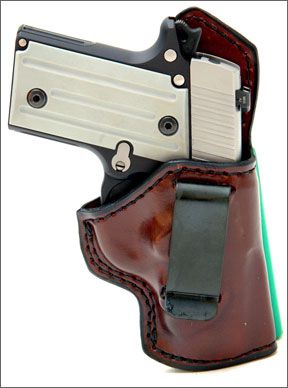
clicked on the words Walther America in fine print. Up came the Walther page. We then clicked on the word Firearms in the upper left hand corner. Walther America lists six handgun lines and one carbine. The PK380 was first available in March of 2009 and its profile complete with polymer frame reflects the P99 pistol on a slightly smaller scale. A check of the dimensions shows an overall length and height of about 6.5 inches by 5.2 inches. Barrel length was listed as 3.66 inches. The full-size P99 pistols were listed as measuring 7.1 inches long by about 5.3 inches tall with a 4.2-inch long barrel. In both cases the polymer grip frame offered a teardrop or birds-head profile to fill the palm. Most noticeable of the features shared with the bigger gun was the ambidextrous magazine release hiding in the rear lower contour of the trigger guard. The polymer lower also featured a full-length dustcover with integral accessory rail and flush-fit takedown latch.
The slide on the PK380 was scored with rear cocking serrations and topped with a three-dot sight system. The sights were made from polymer, and we noticed that the rear notch was very wide. The rear unit was adjustable for windage only. Magazine capacity was 8 rounds held in a single column. The basepad added about one-half inch to the front strap and looked as though it should have been mated to a wide-body high-capacity magazine. Three such magazines were supplied.
The only way to lock the slide back the on the PK380 was to insert an empty magazine and let the mechanism react to this condition. Field stripping began with using a special key to unlock the takedown levers located in the frame directly above the center of the trigger guard. Access to the lock was from either side of the frame, and the two levers, which were more like panels, needed to be pulled down simultaneously. Requiring a key to begin field stripping is not ideal in our view, as the key can easily be misplaced. In fact, we learned that replacement keys were not always immediately available in lieu of shipment from the German factory.
A safety lever was located on both sides of the slide just below the rear sight. The lever action was forward of its hinge with safe-on at about seven oclock. The safe-off ready-to-fire position was when the lever was swept upward in line with the bore. The hammer had a rather short stem. The spur or top of the hammer was round with grooves for grip. But these grooves were not very effective, in our view. Combined with a slick finish and an almost ball-like profile, we were hesitant to perform a manual decock as required for hammer-down carry. The routine for manual decocking was to rack the slide and fill the chamber. This can be done with the pistol on safe. With the lever still in the on-safe position, the hammer is then held back by the shooter. The trigger was pressed until it clicked. At this point the index finger was removed from the trigger. The hammer could then be safely lowered. Actually, once the chamber was loaded and the gun placed on safe, the trigger can be used to drop the hammer to a safe position without the shooter controlling the hammer. But loading the gun, putting the gun on safe and pulling the trigger is not recommended.
At the bench we noticed right away that the rear notch was so wide it was going to be difficult to regulate and compare the amount of light showing between the sides of the front sight blade and the inner walls of the rear sight notch. We took note that this overdraft of peripheral vision might pay off during our action test. But from the bench we found it very difficult to print a five-shot group that measured less than 3.0 inches across. With plenty of sight radius and a trigger free of any real detriments, we would expect 15-yard groups to measure 2.0 inches or less with little trouble. According to factory representatives the PK380 is a blowback-operated pistol with cantilever-style action instead of a fixed barrel. But our PK380 seemed to be slightly ill-timed. With debris from shots occasionally spitting back at our shooter, the gun was either firing slightly out of battery or unlocking prematurely.
To perform our action test we decided to shoot our PK380 in TDA mode only. This meant beginning with hammer down and double-action first shot. We could have fired this test with the hammer back and the pistol on safe, but discovered that we would have to change our grip to deactivate the safety each time we presented the weapon. Usually we would favor single-action-only fire for its speed and efficiency. But having to shift the gun to deactivate the safety and then shift it again to achieve an effective shooting grip was not going to help. Regarding decocking, before each run we had the luxury of
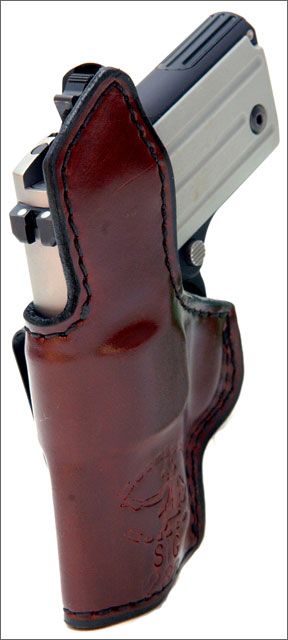
being at a shooting range. This meant we could point the gun in a truly safe direction when we decocked the hammer.
Our initial runs from DA/SA were skewed as we had to learn to pick a balance between the two triggers. We found the difference between the double-action and single-action triggers to be pronounced. But once we found our grip or, as we would prefer to describe it, our platform, elapsed times became to shrink. Still, if we failed to concentrate our elapsed times would suffer. Our best runs were completed in an average time of about 2.15 seconds. Other than two stray shots well to the left of the A-zone, accuracy throughout our action tests was very good.
Our Team Said: Aside from the friendly grip profile, were not sure how well the mission has been accomplished. We think its single-action only capability was hindered by an awkward safety, and the limited amount of grip surface on the small hammer made us wary of decocking. The sights favored speed over accuracy, which in this application was okay by us. But the takedown procedure reflects afterthought in our view, and, again, and were not really sure in what condition this gun was meant to be carried.
Sig Sauer P238 No. 238-380-TSS 380 ACP, $643
When we referred to the P238 as representing the new generation of 380-caliber pistols, we werent referring to its design or its origin. Perhaps the word “regeneration” would be more accurate. Indeed, the Sig Sauer P238 has been referred to as a Colt Mustang clone. Nevertheless, here is a major manufacturer jumping in feet first with product availability well in advance of new designs from any number of makers. In terms of size, each of our other test pistols tower over the P238, yet it wouldnt take much trick photography to portray the P238 as a full-size 1911. Operation of the P238 was described in the owners manual as a mechanically locked, short-recoil-operation pistol with semi-automatic reloading.
As of April 2010 the sigsauer.com website listed nine variations of the P238. But at the SHOT Show in January, we saw many, many more. Our two-tone model was priced a little higher than the basic $629 Nitron model, but lower than the $735 laser-equipped Tactical P238. Our gun was built on an alloy frame with a stainless-steel slide. The slide featured cocking serrations to the rear and night sights front and back. The black anodized aluminum frame was accented by gray polymer grip panels held in place by Allen head screws. The left side of the gun featured a grooved magazine button, slide stop and thumb safety each matching the slide. The thumb safety was left side only, and the right side of the pistol was accented with stainless steel pins. The backstrap was flat with vertical lines capping the mainspring housing and the surface along the front strap. The distance from the bottom of the trigger guard to the magazine well was literally about “two fingers” in length. A single flush-fit six-round magazine was supplied.
The trigger, which offered about 10.5 pounds of resistance, was left unrelieved and coated to match the dark frame. The hammer was skeletonized with a triangular profile that looked very much like the Cylinder & Slide Ultra Light Speed II hammer sold in the Brownells catalog. One burning question was that since this was a single-action-only pistol and the preferred method of carry would be hammer-back safety-on, would we really be willing to carry it cocked and locked? Lets look at that more closely:
-
The thumb safety was left side only. This limits the possibility of it being switched to off-safe.
-
The detent that kept the thumb lever on, or off, was oversized (huge, in fact), so the chances of accidentally switching it the wrong way was small.
-
The P238 did not offer a grip safety, but included passive safeties such as a firing pin safety, a hammer safety intercept notch, and disconnector. So, all in, the gun could be carried safely but also it could be very ready to go.
Enchanting as the little P238 was, we couldnt wait to break it down. We began by ejecting the lone supplied magazine. A press of the button shot it across the room. Were we really going to speedload this little gun?
The top end was removed by retracting the slide so that the slide stop tab (the flange that rides on the inner side of the slide rail) was in line with the slide disassembly notch. There was very little of the slide-stop pin protruding from the frame on the right hand side, but only a little pressure was needed to move it far enough so that it could be pulled free from the other side. The slide, barrel and a full-length guide rod rode easily forward off of the frame. Weve become so used to seeing the Seecamp-style dual spring and plunger recoil assembly in shorter guns that we were surprised by not only the long guide rod but the ordinary looking single filament recoil spring. The barrel utilized a fixed link with kidney-shaped hole. When we removed the slide, the ejector popped up. It looked like a curved finger. During reassembly the only trick was to push the ejector down and out of the way as we eased the slide back on to the frame.
In lieu of the P238s shorter sight radius we could have chosen to shoot groups from say, 10 yards instead of 15. But why not underline the difference between compact pistols and a truly sub-compact handgun. From the 15-yard bench the P238 delivered five-shot groups measuring between 2.4 inches and 3.0 inches across firing the PMC Bronze ammunition. The Sellier & Bellot ammunition was less consistent, with a spread of 2.7 inches to 3.4 inches. The Hornady Critical Defense ammunition was placed in groups 3.0 inches to 3.4 inches across. In terms of power, the 2.7-inch-long barrel launched bullets at a velocity of about 878 fps on average. With the exception of the CZ 83, which led the field by as much as 150 fps in some cases, this was comparable to our other test pistols.
In our action test we were able to achieve something that has become quite rare. We did manage to push some shots to the left of the center mass A-zone shots to the cranial pocket filled the B-zone without error. In terms of elapsed times, our first attempt was timid, taking 2.74 seconds to complete. Our next run was over in 2.30 seconds. Then we settled in to an average rhythm that spent about 2.20 seconds per run. We found the trigger to be smooth and consistent but a little heavy. In light of how this gun would be carried we find the heavy trigger to be perfectly acceptable. We should point out however that we had to put aside the preferred technique of using only the pad of the index finger to press the trigger. Instead, the heavier trigger (and the small size of the frame) caused us to put more finger through the trigger guard than were used to. More often than not we pressed the trigger with the crook at the first joint of the index finger. Nonetheless, we found shooting the P238 to be surprisingly pleasant.
Our Team Said: We could find no flaw in the execution of this design. Sig Sauer has made the miniaturization of a 1911-styled pistol look easy. Nor is the P238 cost prohibitive. Were not sure how usable this gun will be simply from the standpoint of it being almost too small to deploy quickly. Nevertheless, its appeal is obvious.



























